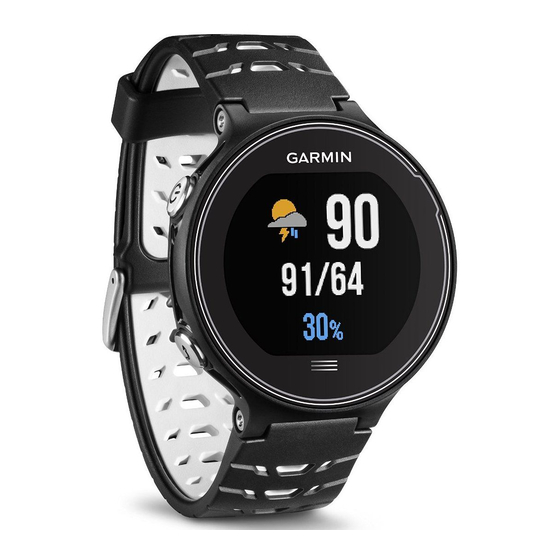- ページ 13
見る Garmin Forerunner 630のPDF オーナーズマニュアルをオンラインで閲覧またはダウンロードできます。Garmin Forerunner 630 24 ページ。

Predicted race times: Your device uses the VO2 max. estimate
and published data sources to provide a target race time
based on your current state of fitness. This projection also
presumes you have completed the proper training for the
race.
Recovery advisor: The recovery advisor displays how much
time remains before you are fully recovered and ready for the
next hard workout.
Stress score: Stress score measures your heart rate variability
while standing still for 3 minutes. It provides your overall
stress level. The scale is 1 to 100, and a lower score
indicates a lower stress level.
Performance condition: Your performance condition is a real-
time assessment after running for 6 to 20 minutes. It can be
added as a data field so you can view your performance
condition during the rest of your run. It compares your real-
time condition to your average fitness level.
Lactate threshold: Lactate threshold is the point where your
muscles start to rapidly fatigue. Your device measures your
lactate threshold level using heart rate and pace.
About VO2 Max. Estimates
VO2 max. is the maximum volume of oxygen (in milliliters) you
can consume per minute per kilogram of body weight at your
maximum performance. In simple terms, VO2 max. is an
indication of athletic performance and should increase as your
level of fitness improves. VO2 max. estimates are provided and
supported by Firstbeat Technologies Ltd. You can use your
Garmin device paired with a compatible heart rate monitor to
display your running VO2 max. estimate.
Your VO2 max. estimate appears as a number and position on
the color gauge.
Purple
Blue
Green
Orange
Red
VO2 max. data and analysis is provided with permission from
The Cooper Institute
®
. For more information, see the appendix
(VO2 Max. Standard Ratings, page
www.CooperInstitute.org.
Getting Your VO2 Max. Estimate for Running
This feature requires a heart rate monitor.
For the most accurate estimate, complete the user profile setup
(Setting Up Your User Profile, page
maximum heart rate
(Setting Your Heart Rate Zones, page
The estimate may seem inaccurate at first. The device requires
a few runs to learn about your running performance.
1
Run for at least 10 minutes outdoors.
2
After your run, select Save.
3
Select
> My Stats > VO2 Max..
Viewing Your Predicted Race Times
This feature requires a heart rate monitor.
ANT+ Sensors
Superior
Excellent
Good
Fair
Poor
16), and go to
10), and set your
8).
For the most accurate estimate, complete the user profile setup
(Setting Up Your User Profile, page
maximum heart rate
(Setting Your Heart Rate Zones, page
Your device uses the VO2 max. estimate
Estimates, page
9) and published data sources to provide a
target race time based on your current state of fitness. This
projection also presumes you have completed the proper
training for the race.
NOTE: The projections may seem inaccurate at first. The device
requires a few runs to learn about your running performance.
Select
> My Stats > Race Predictor.
Your projected race times appear for 5K, 10K, half marathon,
and marathon distances.
Recovery Advisor
You can use your Garmin device with a heart rate monitor to
display how much time remains before you are fully recovered
and ready for the next hard workout. Recovery advisor
technology is provided and supported by Firstbeat.
Recovery time: The recovery time appears immediately
following an activity. The time counts down until it is optimal
for you to attempt another hard workout.
Turning On the Recovery Advisor
For the most accurate estimate, complete the user profile setup
(Setting Up Your User Profile, page
maximum heart rate
(Setting Your Heart Rate Zones, page
1
Select
> My Stats > Recovery Advisor > Status > On.
2
Go for a run.
After 6 to 20 minutes, your performance condition appears
(Viewing Your Performance Condition, page
3
After your run, select Save.
The recovery time appears. The maximum time is 4 days.
Recovery Heart Rate
If you are training with a heart rate monitor, you can check your
recovery heart rate value after each activity. Recovery heart rate
is the difference between your exercising heart rate and your
heart rate two minutes after the exercise has stopped. For
example, after a typical training run, you stop the timer. Your
heart rate is 140 bpm. After two minutes of no activity or cool
down, your heart rate is 90 bpm. Your recovery heart rate is 50
bpm (140 minus 90). Some studies have linked recovery heart
rate to cardiac health. Higher numbers generally indicate
healthier hearts.
TIP: For best results, you should stop moving for two minutes
while the device calculates your recovery heart rate value. You
can save or discard the activity after this value appears.
Lactate Threshold
Lactate threshold is the exercise intensity at which lactate (lactic
acid) starts to accumulate in the bloodstream. In running, it is
the estimated level of effort or pace. When a runner exceeds the
threshold, fatigue starts to increase at an accelerating rate. For
experienced runners, the threshold occurs at approximately 90%
of their maximum heart rate and between 10k and half-marathon
race pace. For average runners, the lactate threshold often
occurs well below 90% of maximum heart rate. Knowing your
10), and set your
8).
(About VO2 Max.
10), and set your
8).
10).
9
